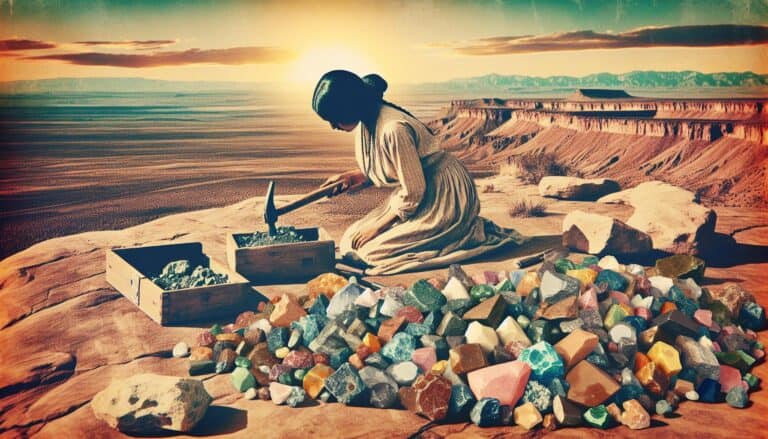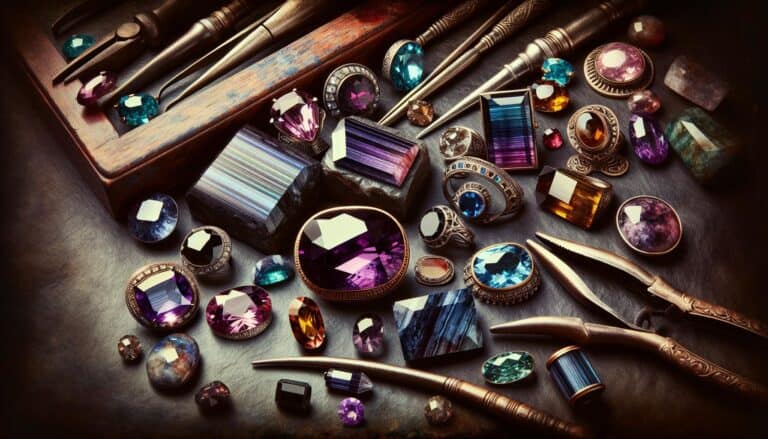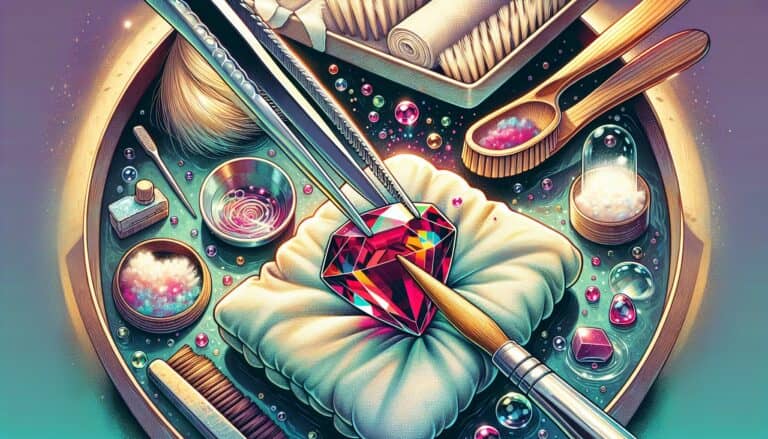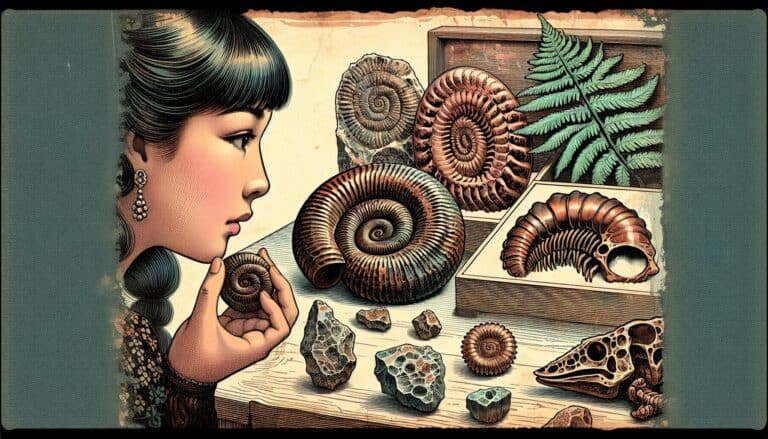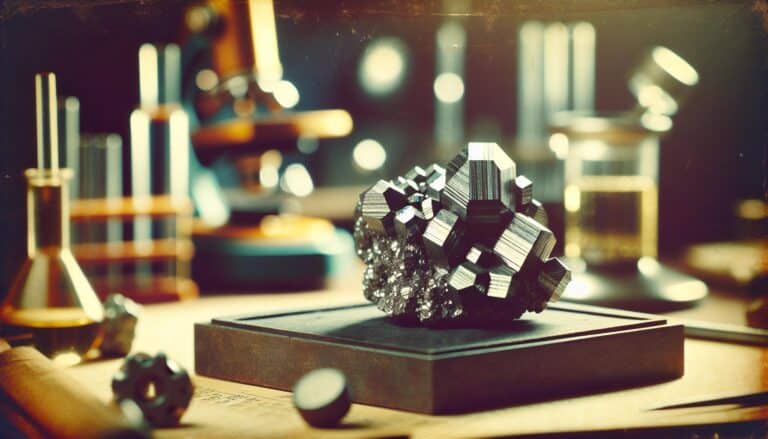Discovering the secrets of identifying rough sapphire can be as thrilling as unearthing a hidden treasure.
You’re about to learn how to distinguish these precious gems from ordinary stones. With their alluring hues and significant value, rough sapphires are a gem hunter’s dream, but knowing what to look for is key.
You’ll find that color, transparency, and crystal structure are your main clues. By the end of this guide, you’ll be spotting rough sapphires with a discerning eye, ready to pick out the most promising pieces.
Whether you’re a seasoned collector or a curious newbie, the journey to recognizing the true beauty of rough sapphires starts here.
To identify rough sapphire, look for hexagonal crystal structures, deep blue hues, and silk-like inclusions. Conduct a streak test for a white streak, check for non-magnetic properties, and verify hardness with a steel knife, as sapphires are hard (Mohs scale 9). Note their single refraction and specific gravity around 4.0.
How to Identify Rough Sapphire Through Testing
Visual Inspection
First, asses the stone’s appearance closely. Search for telltale signs of sapphire, such as hefty inclusions, hexagonal crystal formations, and a lack of cleavage, which distinguishes sapphires from other gems. A jeweler’s loupe can be instrumental in spotting these features. If the gem has a blueish hue or silk-like inclusions, it may further indicate a rough sapphire.
The Streak Test
Conduct the streak test by rubbing the stone against unglazed porcelain. Sapphires leave a white streak, if at all. This test is more about what you don’t see—sapphires rarely leave a colored streak, setting them apart from other minerals.
Magnet Test
You might use a magnet to see if there’s a reaction. Pure sapphires typically do not respond to magnets, but the presence of iron-based impurities could cause a slight magnetic attraction. Be cautious; this isn’t a definitive test for sapphires.
Hardness Test
Take advantage of the Mohs scale of mineral hardness. Sapphires rank at 9, only one step below diamonds. Try scratching the surface with an object of known hardness. If the scratch marks are evident, it’s less likely to be a sapphire.
Birefringence Test
Examine the gem under a polariscope to check for birefringence, which is an optical property where a single ray of light splits into two rays when passing through certain types of crystal. Sapphires exhibit birefringence, and their double refraction can be a reliable identification mark.
Checking The Diaphaneity
Sapphires range from transparent to translucent. Hold the stone up to light. If light passes through, and if the stone allows for some light to pass through without clearly seeing objects through it, it could suggest a rough sapphire.
Single or Double Refraction
Using a dichroscope, you can determine if a stone is singly or doubly refractive. Sapphire exhibits double refraction, which is rare in blue stones. This characteristic is key in distinguishing from glass or synthetic counterfeits, which often show only single refraction.
Refractive Index Test
The refractive index (RI) is a measure of how much a substance bends light. Sapphires have an RI between 1.76 and 1.77. You’ll need a refractometer to perform this test, and it’s worth noting that synthetic sapphires often fall within this range as well.
Finding The Specific Gravity
Weigh the stone first in air and then submerged in water to evaluate its specific gravity, which should be around 4.0 for sapphires. This test may not be definitive when performed on your own, as the equipment needed to detect slight variations in specific gravity is quite precise.
Identifying Rough Sapphires in the Field
When you’re out in the field, your senses are your best tools. Rough sapphires often appear in riverbeds and old streams. Keep an eye out for the glint of a potential sapphire’s luster, the typical blue or purple color, and its hexagonal crystal form, though sapphires do come in various colors.
Recognizing Potential Rough Sapphire Rocks
Understanding the geology of your search area is crucial. Sapphire deposits are often found in regions with volcanic activity. Look for remnants of volcanic rock or ruby, which can indicate the presence of sapphires since they’re both forms of corundum.
Physical Characteristics of Rough Sapphire

When hunting for rough sapphires, you’ll notice these gems have a distinct set of physical characteristics. They usually feature a hexagonal crystal structure, which can provide an initial clue. Moreover, rough sapphires often come in a wide array of colors — ranging from deep blues to yellows, pinks, and even clear. Color can be indicative of a sapphire, but remember that color alone is not a definitive identifier.
The touch and feel of a rough sapphire can also guide you. They possess a vitreous luster, giving them a glass-like appearance. This luster is a tell-tale sign as you sift through stones. Furthermore, they are remarkably hard, rating a solid 9 on the Mohs scale. If you can easily scratch the stone with a steel file, it’s likely not a sapphire.
Another characteristic of these gems is their transparency to translucency. They’re rarely perfectly transparent like some diamonds, but a degree of translucency often suggests you’re on the right track. Size and shape, however, can be highly variable, with rough sapphires appearing in anything from small pebbles to large chunks.
Pay attention to specific gravity, which for sapphires, typically ranges between 3.95 to 4.03. This density can help differentiate them from other similar-looking stones, especially when size and color overlap. Consider investing in a specific gravity testing kit to enhance your accuracy in identifying these gems in the field.
Rough Sapphire vs Star Sapphire vs Sapphire
Sapphires, the allure of the gem world, offer three fascinating facets: Rough Sapphire, Star Sapphire, and Sapphire.
Rough Sapphires emerge from the depths of the Earth in their natural, uncut form. These raw gems boast an organic, unrefined beauty with irregular shapes and rough textures. Crafting them into polished gems requires skill and expertise, revealing their hidden brilliance.
Star Sapphires, on the other hand, are a celestial marvel. These gems exhibit a captivating optical phenomenon known as asterism, forming a mesmerizing star-like pattern with six rays when exposed to direct light. This ethereal effect is caused by the presence of rutile needle inclusions within the stone, creating a unique and enchanting display.
Sapphire, as a category, encompasses the polished and refined gemstones. They are celebrated for their vibrant colors, remarkable durability (second only to diamonds), and the symbolism they hold, representing qualities such as loyalty, wisdom, and nobility. While blue sapphires are the most renowned, sapphires can be found in an array of colors, including enchanting shades of pink, yellow, and even colorless varieties.
How Are Rough Sapphire Formed?
When you’re on the hunt for rough sapphire, it’s essential to understand the circumstances that lead to their creation. Sapphires are formed deep within the Earth under specific conditions that require an exquisite balance of heat and pressure. This process is typically linked to the movement of tectonic plates, which can create the high-pressure environments necessary for sapphire genesis.
Corundum, the mineral family to which sapphires belong, crystallizes from a melt in igneous rocks or from fluids in metamorphic rocks. What distinguishes a sapphire from other corundum is the presence of trace elements like iron, titanium, chromium, copper, or magnesium. It’s these elements that give sapphires their wide color spectrum, aside from the classic blue.
The formation of sapphires often involves a mineral called aluminum oxide. As rocks rich in this mineral are subjected to those extreme conditions, they undergo transformative changes over millions of years, ultimately leading to sapphire formation. You’ll find that the rough sapphires encountered in riverbeds and streams are those that have been naturally eroded from these primary deposits over time.
Topographical maps and understanding local geology become useful tools given that regions with a history of volcanic activity or mountain formation are more likely to harbor sapphire deposits. Thus, equipping yourself with geology basics enhances your identification skills, helping you discern potential sapphire-rich areas that might go unnoticed by the untrained eye.
Preparation for Rough Sapphire Hunting
Gathering the Right Tools
Embarking on a quest for rough sapphires requires equipping yourself with essential tools to maximize your chances of success. Your toolkit should include a sturdy geologist’s hammer for breaking rocks and a chisel for prying apart stubborn stones. You’ll also need a set of sieves with various mesh sizes; these are invaluable for sifting through sediment and isolating potential gems.
Don’t overlook the importance of a good magnifying glass or loupe; inspecting small stones closely for that hint of sapphire blue can make all the difference. Carry a pair of heavy-duty gloves to protect your hands from sharp rocks and a strong, lightweight backpack to carry your finds.
For serious enthusiasts, advanced equipment like a portable electronic scale for measuring specific gravity and a refractometer for testing refractive index can prove useful. These instruments allow for more precise identification of rough sapphires in the field.
Safety Considerations
Your safety is paramount when hunting for rough sapphires. Always inform someone of your destination and expected return time. You’re likely to be working in remote areas with varying terrain, and an unexpected accident without help nearby could turn serious.
Here’s what else you should include in your safety gear:
- Wear sturdy boots with strong grip for navigating slippery riverbeds or rocky outcrops.
- Protective eyewear is a must to shield your eyes from flying debris when breaking rocks.
- Always have a first aid kit on hand for treating cuts or scrapes immediately.
Being prepared for the elements is also crucial. Bring along sunscreen, a hat, and plenty of water to stay hydrated. Considering weather patterns is important too; an unexpected thunderstorm puts you at risk of flash floods, especially in riverbeds.
Another often overlooked aspect is wildlife. Learn about the local fauna, as some regions are home to dangerous snakes or insects. You might need to add snake gaiters or insect repellent to your equipment list.
Remember that while the allure of finding rough sapphires is strong, your well-being should always take precedence. Take these precautions, and you’re set for a safe and thrilling adventure in the world of gem hunting.
Handling and Care of Found Rough Sapphire
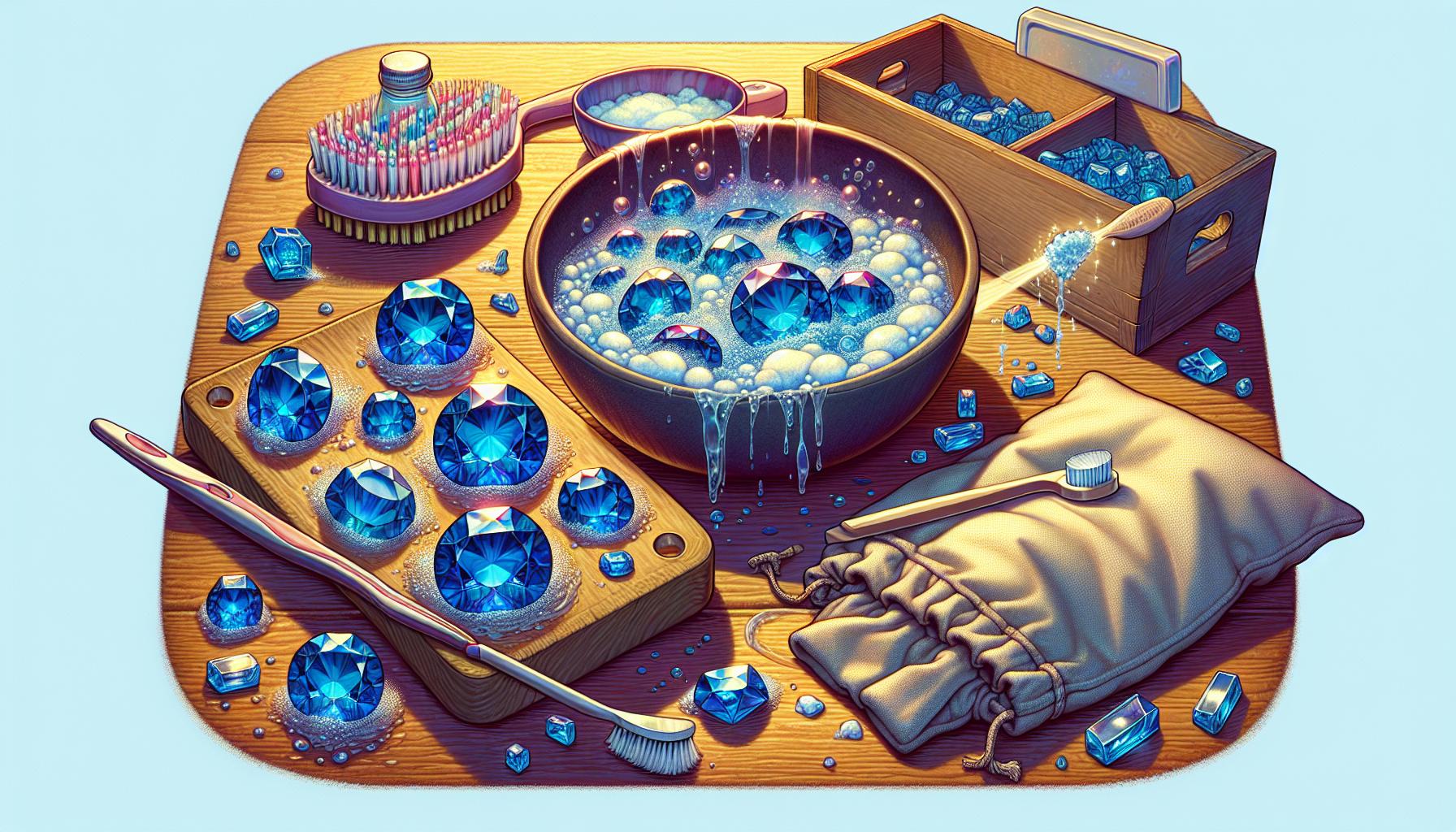
After you’ve successfully identified and harvested rough sapphires, the next vital step is to ensure they’re properly handled and cared for. Taking appropriate measures can maintain their quality and prepare them for any future cutting or appraisal processes.
Cleaning Rough Sapphires
Begin by gently washing your rough sapphires in a bowl of warm soapy water to remove any dirt and sediment. A soft toothbrush can be useful for dislodging particles from crevices. Exercise caution to avoid scratching the gemstones as even though they are hard, they can still suffer from surface abrasions.
Once clean, rinse the sapphires thoroughly in clean water to remove any soap residue. Pat them dry with a soft, lint-free cloth, moving with the grain of any visible structures within the stone to preserve their natural shape and surface.
Storing Rough Sapphires
Appropriate storage is essential for maintaining the integrity of your rough sapphires. Before storing, ensure they are fully dry to prevent any long-term moisture damage. When selecting a storage method, consider these options for optimal preservation:
- Individual Cloth Pouches: To prevent the stones from scratching each other, store each sapphire in a separate soft cloth pouch.
- Divided Storage Boxes: These boxes are excellent for organizing multiple gems without them coming into contact with one another.
- Acid-Free Tissue Paper: Wrap each stone carefully in acid-free tissue paper before placing them in a container; this not only protects from scratches but also from potential chemical reactions with the container’s material.
Remember not to store rough sapphires in direct sunlight or humid environments as prolonged exposure can alter their appearance over time. Security is another concern—you’ll want to keep your valuable finds in a locked safe or a secure location to prevent theft or loss.
By following these guidelines, you’ll preserve the beauty and value of your rough sapphires. Whether you’re a hobbyist or a serious collector, respecting the basic principles of gemstone care will serve you well in all your sapphire endeavors.
Conclusion: Confirming Rough Sapphire are Real
Armed with the right techniques and a discerning eye, you’re now equipped to confirm the authenticity of rough sapphires.
Remember, the key lies in a comprehensive approach that combines visual cues with scientific tests. Your newfound knowledge on specific gravity, refraction, and the stone’s unique physical characteristics will serve as invaluable tools on your quest. As you embark on your search, prioritize safety and be mindful of the proper care for your precious finds. With patience and attention to detail, you’ll be able to distinguish true sapphires from mere imitations and ensure that their natural allure is preserved for years to come.
Happy hunting!


